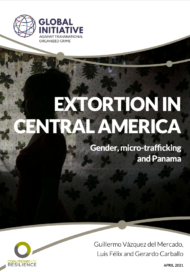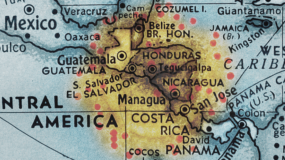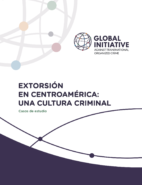Extortion is one of the main crimes that negatively affect citizen security in the Northern Triangle of Central America (Guatemala, Honduras and El Salvador) and, to a lesser extent, Costa Rica and Panama.
Given the widespread presence of this crime in the region, the availability, relevance and reliability of data on extortion are essential to understand its magnitude, as well as to develop evidence-based public policies to contain it and build community resilience. However, unlike for other crimes such as homicides, public institutions in the countries of the region have not yet developed a specific methodology to collect, produce and disseminate up-to-date, reliable, relevant and high-quality data on extortion. This shortcoming hampers the analysis and research needed to measure the real magnitude of this crime and to generate evidence-based public policies. Furthermore, the dynamics of cooperation and territorial disputes between organized crime groups and the lack of knowledge about the variables involved in establishing an extortion rate are additional factors that merit further investigation, as they make it difficult for public institutions to measure extortion.
This report analyzes the availability of public data on extortion and the transparency mechanisms for accessing it. To do so, the authors reviewed the availability and accessibility of data on extortion from official sources in the countries concerned, particularly the websites of national police forces and prosecutors’ offices. It also presents a new tool, developed as part of the Coalitions for Resilience project, which addresses the challenges and areas of opportunity in collecting reliable, comparative and systematic data on extortion in the region. The main contribution of this methodology is the proposal of nine indicators to measure the monitoring of the crime of extortion throughout the entire chain of the criminal justice system.
Sign up to the GI-TOC Observatory in Central America (CAM-Obs) mailing List
La extorsión es uno de los principales delitos que afectan negativamente a la seguridad ciudadana de los países del norte de Centroamérica (Guatemala, Honduras y el Salvador) y, en menor medida, Costa Rica y Panamá.
Ante la presencia generalizada de este fenómeno criminal en la región, la disponibilidad, pertinencia y confiabilidad de los datos sobre extorsión son fundamentales para comprender su magnitud, así como para desarrollar políticas públicas fundamentadas en evidencia que permitan contenerlo y fomentar la generación de resiliencia a nivel comunitario. Sin embargo, a diferencia de otros crímenes como los homicidios, las instituciones públicas de los países de la región no han desarrollado todavía una metodología específica para recolectar, elaborar y difundir datos sobre extorsión actualizados, confiables, pertinentes y de calidad. Esta carencia dificulta el análisis y la investigación necesarios para dimensionar la magnitud real de este delito y generar políticas públicas sustentadas en evidencia. Asimismo, las dinámicas de cooperación y disputa territorial entre grupos de crimen organizado y el desconocimiento sobre las variables que interceden en el establecimiento de una tasa de extorsión constituyen factores adicionales que merecen una investigación más profunda, pues dificultan la medición de la extorsión por parte de las instituciones públicas.
En este informe se analiza la disponibilidad de los datos públicos sobre extorsión y los mecanismos de transparencia para acceder a ellos. Para ello, los autores revisaron la disponibilidad y accesibilidad de datos sobre extorsión en fuentes oficiales de los países en cuestión, particularmente las páginas web de cuerpos de policía nacionales y fiscalías. También se presenta una nueva metodología, desarrollada en el marco del proyecto Coaliciones por la Resiliencia, que aborda los retos y áreas de oportunidad en la recolección de datos confiables, comparados y sistemáticos sobre extorsión en la región. La contribución principal de esta metodología es la propuesta de nueve indicadores para medir el seguimiento al delito de extorsión a través de toda la cadena del sistema de justicia penal.
Sign up to the GI-TOC Observatory in Central America (CAM-Obs) mailing List





